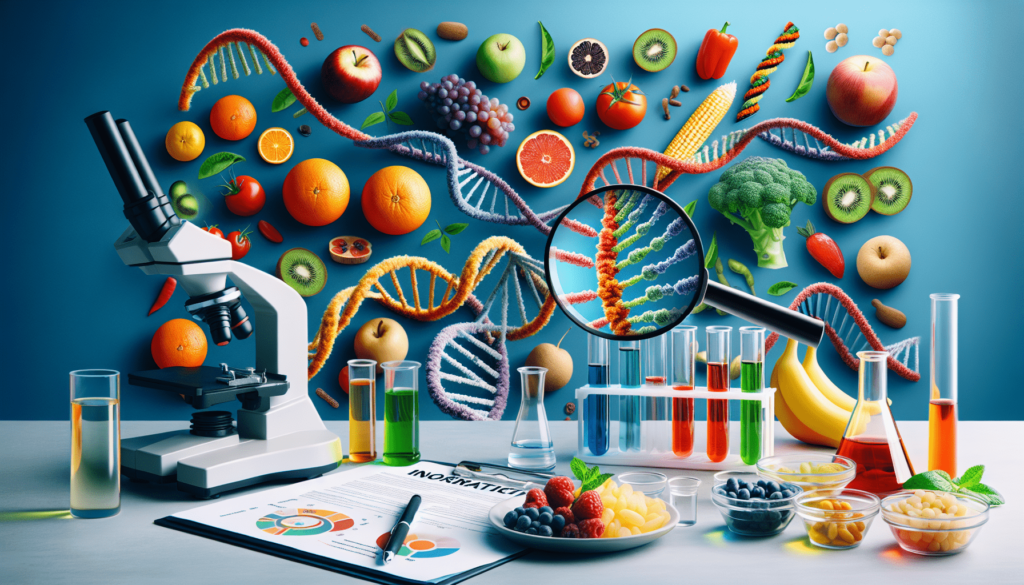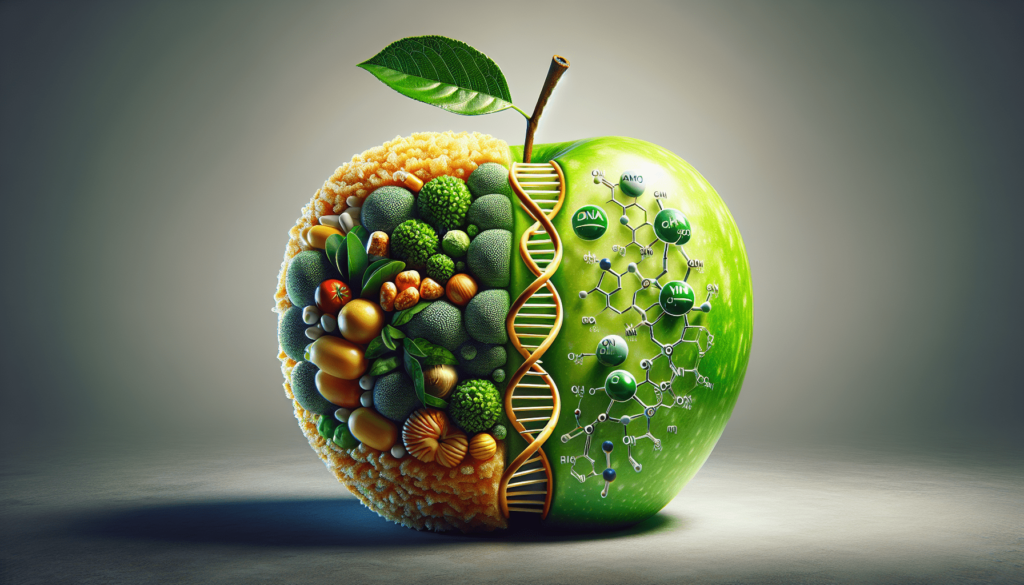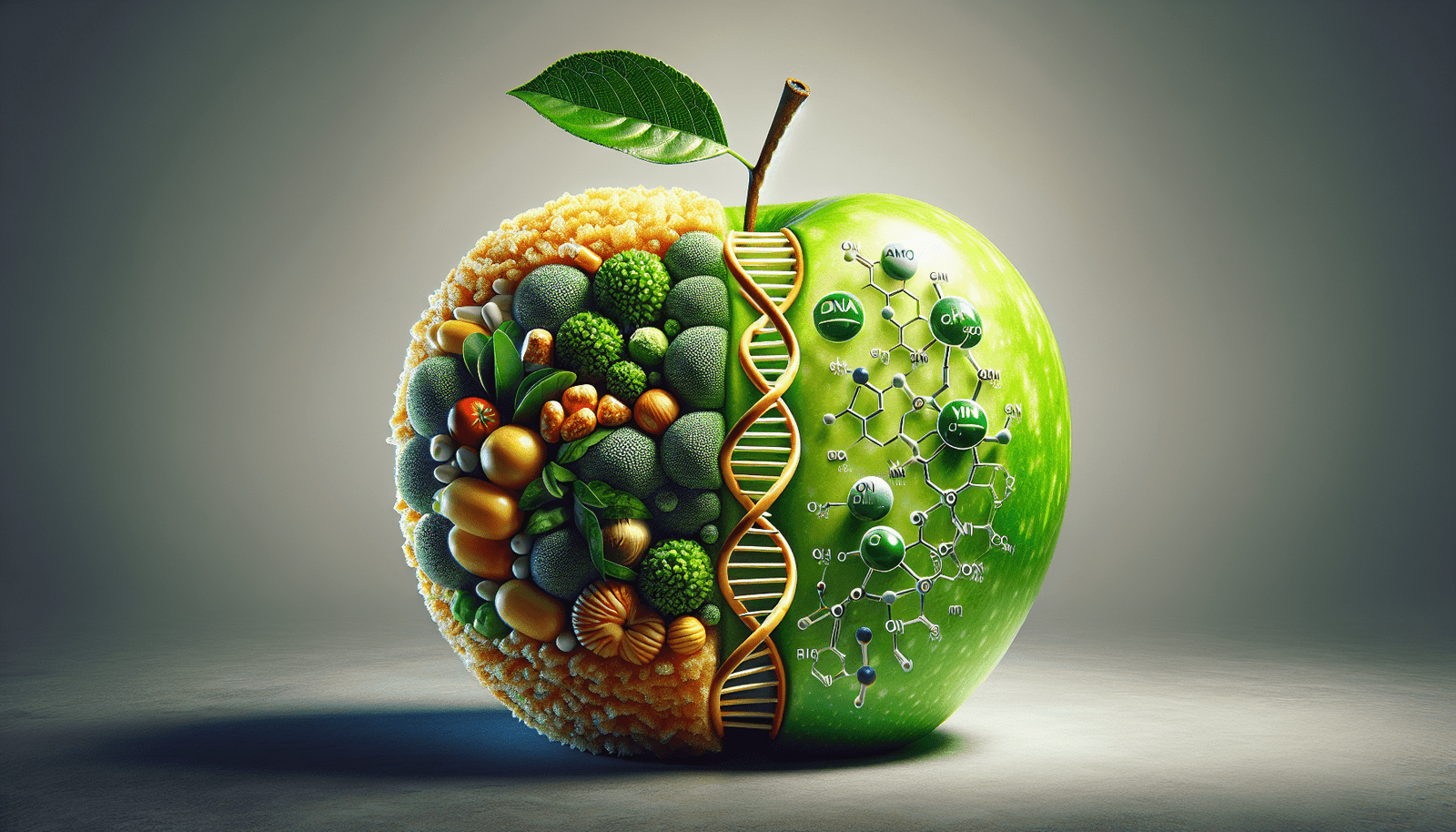In a world where we are constantly bombarded with contradictory information about our food, it’s imperative to separate fact from fiction. The topic of genetically modified organisms (GMOs) and their impact on nutrition has been a subject of intense debate. Many questions arise: Are GMOs harmful to our health? Do they provide any nutritional benefits? In this article, we will delve deeper into the fascinating world of GMOs and nutrition, seeking the truth and shedding light on this complex topic. So, grab a cup of tea, sit back, and let’s unravel the truth together.

What Are GMOs?
GMOs, or genetically modified organisms, are living organisms whose genetic material has been manipulated using biotechnology techniques. This involves the transfer of specific genes from one organism to another, resulting in genetic modifications that wouldn’t occur naturally through traditional breeding methods. The purpose of genetically modifying organisms is to enhance desired traits, such as improving crop yield, enhancing nutritional content, or increasing resistance to pests and diseases.
The Controversy Surrounding GMOs
GMOs have sparked a considerable amount of controversy and debate. On one hand, proponents argue that GMOs offer numerous benefits, including increased food production, improved nutritional content, and resilience against environmental challenges. On the other hand, opponents raise concerns about the potential risks GMOs pose to human health, the environment, and biodiversity. It is important to examine the pros and cons, as well as address public perception and misconceptions surrounding GMOs.
Pros and Cons of GMOs
Proponents of GMOs highlight their potential to alleviate food scarcity by increasing crop yields. This can help address global hunger and improve food security. Additionally, genetic modification allows for the enhancement of nutritional content in crops. By introducing specific genes into plants, scientists can improve the levels of essential nutrients, vitamins, and minerals, making them more beneficial to consumer health. GMOs also have the capacity to reduce the use of chemical pesticides, as some genetically modified crops possess natural resistance to pests and diseases.
However, concerns exist regarding the environmental impact of GMOs. Critics argue that genetically modified crops may harm biodiversity by potentially crossbreeding with wild plants or disrupting natural ecosystems. Another contentious issue is the ownership and control of GMO seeds, as some biotech companies patent their genetically modified varieties, leading to concerns over corporate control of the global food supply. It is important to weigh these pros and cons when evaluating GMOs.
Public Perception and Misconceptions
Public perception plays a crucial role in the controversy surrounding GMOs. Due to limited knowledge and misinformation, many individuals have misconceptions about genetically modified foods. Some believe that consuming GMOs will directly harm their health, despite extensive scientific evidence suggesting otherwise. This misconception is often fueled by sensationalized media coverage and a lack of understanding of the rigorous safety assessments that GMOs undergo before reaching the market.
To address these misconceptions, it is essential to promote accurate information and educate the public about the science behind GMOs. Engaging in open, transparent dialogue and making information accessible can help dispel myths and ensure that people can make informed decisions about their food choices.
GMOs and Nutritional Content
How GMOs Are Engineered for Nutrition
One of the key benefits of GMOs is their potential to enhance nutritional content in crops. Scientists have developed genetic modification techniques that allow for the introduction of genes responsible for producing specific nutrients into plants. For example, a genetically modified rice variety called Golden Rice was developed to address vitamin A deficiency in developing countries. By incorporating genes responsible for beta-carotene production, Golden Rice provides a significant source of this essential nutrient.
Furthermore, genetic modification enables the development of crops that are more resistant to nutrient deficiencies. By introducing genes that enhance nutrient uptake, such as iron or zinc, genetically modified crops can help address micronutrient deficiencies, which are prevalent in many regions around the world.
Effects of Genetic Modification on Nutritional Profiles
Studies comparing the nutritional profiles of GMOs and non-GMOs have indicated that there are generally no significant differences in terms of macronutrients like carbohydrates, fats, and proteins. Additionally, GMOs have been shown to be nutritionally equivalent to their non-GMO counterparts in terms of vitamin and mineral content. The genetic modifications introduced to enhance nutritional content do not have any negative impact on the overall nutritional value of the crops.
It is important to note that the nutritional composition of a crop is influenced by multiple factors, including plant variety, growing conditions, and post-harvest handling. Thus, any differences observed between GMO and non-GMO varieties should be evaluated in the context of these factors, rather than solely attributing them to the genetic modification process.
Studies Comparing Nutritional Value of GMOs and Non-GMOs
Numerous studies have been conducted to compare the nutritional value of GMOs and non-GMOs, and they consistently show no significant differences. Organizations such as the World Health Organization (WHO), the National Academies of Sciences, Engineering, and Medicine, and the European Food Safety Authority (EFSA) have all concluded that genetically modified crops currently on the market are safe to consume and have nutritional compositions similar to their non-GMO counterparts.
It is important to note that these studies are conducted using rigorous scientific methodologies and follow international standards for assessing the safety and nutritional value of food. By relying on scientific evidence, we can better understand the impact of GMOs on nutritional content and make informed decisions regarding their consumption.
GMOs and Allergenicity
Introduction to Allergens and GMOs
Allergens are substances that can trigger an allergic reaction when encountered by individuals with specific sensitivities. The introduction of new proteins through genetic modification could theoretically introduce new allergens into genetically modified crops. Thus, allergenicity testing is a crucial step in ensuring the safety of GMOs before they reach the market.
Allergenicity Testing of GMOs
To assess the allergenic potential of genetically modified crops, scientists employ a rigorous testing protocol that includes comparing the introduced protein in the GMO with a database of known allergens. Additionally, simulated digestion studies are conducted to evaluate whether the new protein displays characteristics that promote allergic responses.
If a genetically modified crop is found to have potential allergenicity, it is unlikely to receive regulatory approval for commercial cultivation or consumption. Stringent testing measures are in place to prevent the release of GMOs with allergens into the food supply.
Instances of Allergic Reactions to GMOs
To date, there have been no documented cases of allergic reactions caused by approved GMOs. The allergenic potential of genetically modified crops has been extensively evaluated and regulated to ensure consumer safety. However, it is worth noting that individuals may still have allergies to naturally occurring proteins present in both GMO and non-GMO crops. It is essential for individuals with known allergies to specific foods to continue practicing allergen avoidance, regardless of whether the food is genetically modified or not.

GMOs and Health Risks
Potential Risks of GMO Consumption
Concerns have been raised regarding the potential risks associated with consuming genetically modified foods. Some fear that these modifications could introduce new allergens or toxins into the food supply, potentially causing adverse health effects. However, the extensive testing and regulatory processes that GMOs undergo help minimize these risks.
The potential allergenicity and toxicity of GMOs are thoroughly evaluated during the approval process. Scientific organizations and regulatory agencies assess the safety of GMOs based on substantial scientific evidence, ensuring that only crops that meet rigorous safety standards are approved for commercial use.
Long-term Effects on Human Health
Long-term studies evaluating the health effects of GMO consumption have not revealed any evidence of negative impacts on human health. Organizations such as the WHO, the American Medical Association, and the EFSA have concluded that GMOs currently on the market are safe for human consumption.
Furthermore, it is important to note that genetic modification is a targeted process, focusing on specific traits or characteristics. The modifications introduced are precise and purposeful, minimizing unintended effects on human health. Therefore, the notion that GMOs inherently pose long-term health risks lacks scientific evidence.
Debunking Common Myths About GMOs
Misinformation and misconceptions about GMOs have contributed to widespread concerns. It is important to address some of the common myths and debunk them with scientific evidence:
-
Myth: GMOs cause cancer. Reality: Extensive studies have shown that GMOs currently on the market are safe for human consumption and do not increase the risk of cancer.
-
Myth: GMOs are not adequately tested for safety. Reality: Before GMOs are approved for commercial use, they undergo rigorous testing measures, including assessments of allergenicity, toxicity, and nutritional composition.
-
Myth: GMOs are responsible for the rise in allergies. Reality: Allergies are caused by specific proteins in foods, both naturally occurring and genetically modified. GMOs undergo thorough allergenicity testing to ensure safety.
-
Myth: GMOs harm the environment. Reality: While concerns exist regarding the potential environmental impact of GMOs, the science suggests that GMOs can help reduce pesticide usage and protect natural resources.
By addressing these myths and providing accurate information, it becomes clear that GMOs are extensively evaluated for safety and are not associated with the negative health effects often attributed to them.
GMOs and Nutritional Benefits
Enhanced Nutritional Content in GM Crops
One of the significant advantages of GMOs is their ability to enhance the nutritional content of crops. Through genetic engineering, scientists have been able to introduce genes responsible for the production of specific vitamins, minerals, and other essential nutrients.
For example, vitamin A deficiency is a prevalent global health issue. By genetically modifying crops like rice to produce beta-carotene, a precursor of vitamin A, researchers aim to address this deficiency and improve public health. Similarly, genetically modified crops can be fortified with nutrients such as iron, zinc, and vitamin C, helping to combat micronutrient deficiencies in regions where they are most prevalent.
Biofortification: Addressing Micronutrient Deficiencies
Biofortification refers to the process of increasing the nutrient content of crops through genetic modification or conventional breeding. While both methods can be utilized, genetic modification offers a more targeted and efficient approach.
Biofortified crops have the potential to address hidden hunger, a form of malnutrition where individuals may consume enough calories but lack essential vitamins and minerals. By enhancing the nutritional content of staple crops, biofortification can have a significant impact on public health, particularly in regions where access to diverse diets and dietary supplements is limited.
Potential to Combat Hidden Hunger
Hidden hunger affects millions of individuals worldwide, leading to severe health consequences, especially in vulnerable populations such as women and children. GMOs offer a promising solution to combat hidden hunger by providing crops with enhanced nutrient profiles. Through advances in genetic engineering, scientists are continuously working towards developing crops that can effectively address the nutrient deficiencies prevalent in different parts of the world.
By harnessing the potential of GMOs, we can make significant strides in addressing global nutritional challenges and improving the health and well-being of individuals who currently suffer from hidden hunger.
Labeling and Transparency
Current GMO Labeling Regulations
GMO labeling regulations vary across different countries. Some nations require mandatory labeling of genetically modified foods, while others rely on voluntary labeling or do not have specific regulations in place. In countries with mandatory labeling, genetically modified foods are typically required to be clearly identified on their packaging or through standardized symbols.
The purpose of GMO labeling is to provide consumers with information about the presence of genetically modified ingredients in their food, enabling them to make informed choices. This transparency allows individuals to decide whether they want to support or avoid genetically modified products based on personal preferences or concerns.
The Debate Over Mandatory Labeling
The debate over mandatory GMO labeling revolves around the balance between public knowledge and the potential impact on producers and the food industry as a whole. Supporters argue that consumers have the right to know what they are consuming and should have the option to make informed decisions about their food choices.
Opponents of mandatory labeling argue that there is no scientific evidence supporting the need for GMO labeling, as genetically modified crops on the market have been deemed safe for consumption. They also highlight the potential burden on producers and the potential for increased costs for consumers due to labeling requirements.
The GMO labeling debate is multifaceted, and finding common ground requires careful consideration of both consumer rights and the practical implications for producers and the food industry.
Consumer Right to Know
Regardless of the stance on mandatory labeling, there is a consensus that consumers have the right to know the contents of their food. Transparency in the food industry is essential to build trust and allow individuals to make informed decisions based on accurate information.
While mandatory GMO labeling may not be universally implemented, efforts can still be made to improve transparency and provide consumers with the necessary information. This can be achieved through voluntary labeling initiatives, increased educational campaigns, and accessible platforms that provide detailed information about the sourcing and production methods of food products.
Regulation and Safety Assessment
Approval Process for GMOs
The commercial release of GMOs is subject to a rigorous regulatory process to ensure their safety for human health and the environment. The specifics of this process may vary between countries, but the general principles remain consistent.
Before GMOs can be commercially cultivated or consumed, they must go through several stages of testing and regulatory scrutiny. This includes assessing the potential risks to human health, evaluating the environmental impact, and analyzing the nutritional composition of the genetically modified crop. Regulatory agencies, such as the United States Food and Drug Administration (FDA) and the European Food Safety Authority (EFSA), review these assessments and make their determination regarding the safety and suitability of GMOs for commercialization.
Evaluating the Safety of GMOs
The safety assessment of GMOs is a complex and thorough process that includes comprehensive scientific studies and evaluations. This examination involves the identification and analysis of potential risks associated with the genetic modifications introduced.
The evaluation of GMO safety includes assessments of allergenicity, toxicity, the stability of the introduced traits, and potential ecological risks. Scientists utilize a range of research methods, including in vitro studies, animal feeding trials, and environmental impact assessments, to comprehensively evaluate the potential risks associated with genetically modified crops.
This strict safety assessment process ensures that only genetically modified crops that pose no significant risks to human health or the environment are approved for commercial use.
Regulatory Agencies and Oversight
Regulatory agencies play a crucial role in overseeing the safety and commercialization of GMOs. These organizations are responsible for evaluating the scientific evidence and ensuring regulatory compliance during the entire process. Regulatory agencies also monitor and assess any new scientific developments and emerging technologies related to GMOs.
Examples of regulatory bodies include the FDA and the United States Department of Agriculture (USDA) in the United States, the EFSA in the European Union, and the Food Standards Australia New Zealand (FSANZ) in the Pacific region. These agencies work in collaboration with scientific experts, industry stakeholders, and public input to make informed decisions and protect public safety.
Future Directions in GMO Research
Advancements in Genetic Engineering Techniques
Research and development in the field of genetic engineering continue to advance rapidly. Scientists are exploring and refining new methods and techniques that allow for precise genetic modifications in a variety of organisms. These advancements enable researchers to further enhance the desirable traits and nutritional content of GMOs, making them more effective and beneficial.
Advances in CRISPR-Cas9 gene editing technology have revolutionized the field, allowing for greater precision, efficiency, and ease of genetic modifications. This technology holds immense potential for the development of new GMOs with improved nutritional profiles, enhanced resistance to diseases and pests, and increased environmental sustainability.
Exploring Novel Applications of GMOs
Beyond enhancing crop traits, GMOs are being explored for their potential in various areas. For example, genetically modified microorganisms hold promise in producing valuable compounds, such as medicines and biofuels. Genetic modification also shows potential in addressing specific agricultural challenges, such as improving livestock health and productivity.
As research progresses, innovative applications of genetic modification in various fields will continue to be explored. The potential benefits of GMOs extend beyond agriculture and have the potential to revolutionize industries and address pressing societal challenges.
Addressing Concerns and Improving Public Perception
Addressing concerns and improving public perception surrounding GMOs is essential for the acceptance and adoption of this technology. Engaging in open communication, providing accurate information, and involving the public in discussions about GMOs can help foster trust and transparency.
Scientific organizations, regulatory agencies, and industry stakeholders must continue their efforts to educate the public about the safety, benefits, and processes involved in genetic modification. Aligning communication strategies with public values, promoting independent research, and addressing specific concerns raised by consumers are crucial steps in shaping a more positive attitude towards GMOs.
By fostering an environment of dialogue, transparency, and collaboration, we can work towards an informed society that embraces the potential of genetic modification to address pressing global challenges and improve human well-being.
Conclusion
GMOs have emerged as a powerful tool in addressing various agricultural and nutritional challenges. While controversies surrounding GMOs persist, it is vital to separate fact from fiction and rely on scientific evidence when evaluating their potential benefits and risks.
Extensive research and regulatory processes ensure that GMOs on the market are safe for consumption and have nutritional compositions similar to their non-GMO counterparts. Genetic modification allows for the enhancement of nutritional content in crops and has the potential to combat hidden hunger and address global malnutrition.
Transparency in GMO labeling, increased public education, and ongoing research advancements are key to improving public perception and addressing concerns surrounding GMOs. By fostering open dialogue and informed decision-making, we can harness the potential of GMOs to create a sustainable and food-secure future.

